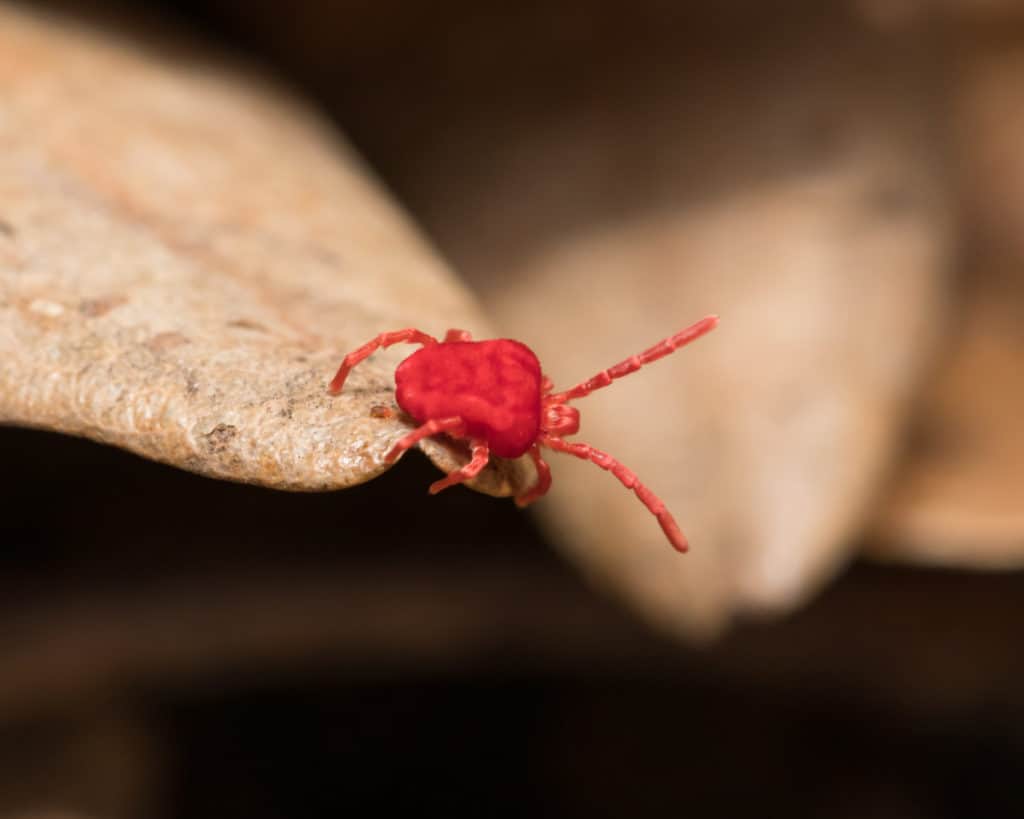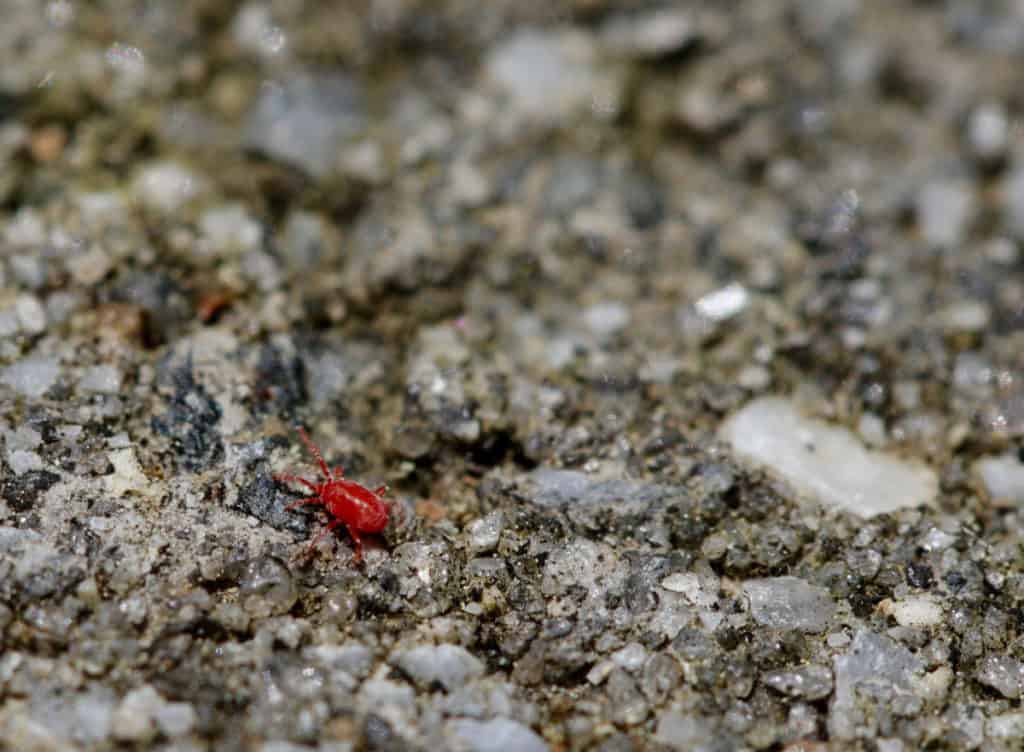When spring comes around, the weather is all mild and nice and the lawn grows into a rich green that is pleasing to the eye. The garden plants, shrubs, and flowers around the home come to life and flourish.
The lush abundance of greenery is a truly welcome sight. However, less welcome is what comes without notice amidst the splendor in the form of tiny red bugs that you can see crawling all over your concrete.
What might they be, and where do they come from?
The tiny red bugs that you see crawling on your concrete are clover mites. You can also notice them crawling around walls, windows, and doors where they appear as moving dark spots to the naked eye. When looking for food they can move in their thousands which is why you often see so many of them.
These tiny bugs can turn into a really big menace if they enter homes and buildings since they come in large numbers. Read on and let’s find out more about them.
What Bug Could It Be?
Clover mites are close relatives of spiders and ticks (arachnids). They belong to the family Bryonia Praetiosa Koch which is one of the larger plant-feeding mites.

Clover mite is one of the “cool season” mites that thrive in cool summer. The mites are attracted to eat well-fed, lush, succulent growth following heavy fertilization of garden plants and turf. They love cool moist environments adjacent to buildings. They appear suddenly in big numbers and stay for a short time but cause a major nuisance.
Low-growing garden plants and grass that are lush and abundant are ideal for clover mites. You can identify host plants by the long winding trails composed of numerous pale spots on the upper surface of leaves. That is the tell-tale sign of clover mite infestation. They suck the sap from the plants. Clover mites don’t wander far from the food sources, though.
Clover mites become a pest after finding their way indoors. This can happen after heavy rain, excessive heat, or a change in the season that can cause migration into buildings. This commonly occurs in early summer and fall, which coincides with peak populations of the clover mites.
Because of their tiny size, they can get into homes and buildings very easily through small gaps in window sills or doors and foundations.
Clover mites lay eggs in the crevices of buildings, under sidings, and on the underside of bark at the base of trees or cracks on fence posts. They lay about 70 eggs each during the spring. The eggs do not hatch in temperatures below 40 degrees Fahrenheit or above 86 degrees Fahrenheit.
They are very sensitive to changes in temperature and during adverse weather conditions, they may either hibernate or become dormant (aestivation) during summer. They tend to over-summer in the egg stage. In fall, the eggs hatch resulting in fall populations. This happens when the daily maximum temperature drops below 70 degrees Fahrenheit.
With the first warm days in spring, the overwintering eggs hatch. The spring generation is usually more troublesome than the fall generation. A generation lives for about one month.
Clover mites are parthenogenetic. This means their populations have only females, and they develop from unfertilized eggs without males. After the eggs hatch, the newly emerged infants move to find food, molts, and pass through two nymphal stages (protonymph and deutonymph).
Why Are Clover Mites Attracted To Concrete?
Clover mites can be found in various places throughout the home, but they have a preference for the south and southwestern side of buildings because of the warmth.
Clover mites can be found at upper levels of buildings after crawling up on outside walls and accessing rooftops, chimneys, and patios. They feed on algae, mildews, and mold that can be found on concrete surfaces at the rooftops.

As previously mentioned, clover mites don’t live far from their food sources. On concrete surfaces at the ground level that support the growth of mildews and mold, the clover mites can move with ease from the grass. The mold and mildews attract them because it is a food source.
When migrating in their thousands from the grass or other plants across concrete they are clearly visible. This may happen their the population explodes in the garden or lawn. They can reproduce quite rapidly in a short while and have several generations in one year.
If you would like more information on the diets of clover mites then check out this article we have written, What Do Clover Mites Eat?
How Long Do Clover Mites Live?
Depending on weather conditions, adult clover mites live for about two weeks outdoors. The mites do not reproduce indoors and will die within a few days due to a lack of host material and plants. The high temperature and low humidity found in most homes are not conducive to clover mite survival. They have a lifespan of approximately 30 days.
Are Clover Mites Harmful?
Clover mites are not harmful to humans or pets. They don’t bite or cause diseases like ticks can. But because they leave a red-brown stain when crushed or wiped, they are considered a severe pest inside homes especially when they invade and seemingly get out of control.
The red stains are pigmentation from the mites’ fluids. They can leave these hard-to-remove stains on curtains, rugs, wallpaper, and carpets. Because they congregate in their thousands, particularly on sunny spots around walls, they can leave unwelcomed stains indoors. They do not cause structural damage to wooden structures or buildings.
How Do You Get Rid Of Clover Mites?
Since clover mites love lush grass and weeds, one effective preventive measure is to remove any grass and weeds up to 24 inches away from the foundation of the house.
Placing barriers in the form of gravel course, sand, marbles, lava rock, or wood chips around the foundation deters clover mites from accessing the foundation.
To avoid the lush growth of host plants, using less fertilizer and avoiding excessive watering can be helpful.
Some flowers and plants are repellent to clover mites and can be used as a barrier to interrupt or stop the movement from the lawn into the building. Some plants that repel clover mites include petunia, salvia, geranium, chrysanthemum, rose, zinnia, yew, arborvitae, juniper, and spruce.
The Wrap Up
Clover mites are mainly nuisance pests and are harmless to humans. They appear suddenly en-masse and for a short period can spread around and through the home or buildings in very large numbers.
They have a short lifecycle of approximately 30 days. They cannot survive indoors for many days. When squished or wiped they leave red, hard-to-remove stains from their pigmentation.
Clover mites feed on plant sap for nutrition. Algae, mildew, and mold on concrete also provide a food source for clover mites. The next time you see them crawling all over the concrete, know there is a source of food nearby.
Sources
https://www.doyourownpestcontrol.com/clovermites.htm
https://www.americanpest.net/blog/post/what-to-do-if-clover-mites-invade-your-home-this-winter
https://www.cooperpest.com/blog/why-are-clover-mites-in-my-house
http://entnemdept.ufl.edu/creatures/orn/mites/clover_mite.htm
